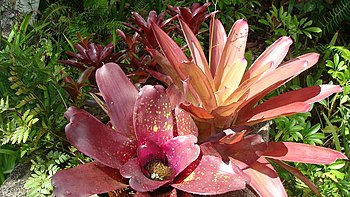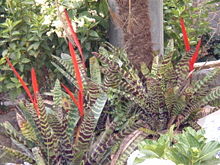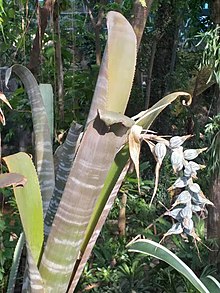Bromeliaceae
The bromeliaceae or bromeliads (Bromeliaceae) form a family of monocotyledonous plants consisting of perennial, terrestrial or epiphytic shrubs or herbs native to from tropical and temperate regions of the Americas except for a single species in West Africa, Pitcairnia feliciana. They have rosette leaves, colorful and showy flowers and bracts, and typically twisted stigmas. Thanks to its sweet fruit, the best-known species in the world is the pineapple or pineapple (Ananas comosus), a crop grown in warm regions. The family is recognized by modern classification systems such as the APG III classification system (2009), and the APWeb (2001 onwards). The circumscription is highly agreed upon and is the one traditionally accepted, the family being monophyletic both by morphological characters as well as by molecular DNA analysis.
Description
They are perennial herbs, terrestrial or epiphytic, or rose-shaped shrubs. The family is diverse enough to include "tank bromeliads" as well as the epiphytic genus Tillandsia, which collects water only from structures on its leaves called trichomes (villi), and even a large number of succulents that inhabit deserts. The largest bromeliad is Puya raimondii, which reaches 3 or 4 m in height in its vegetative part, with a floral spike between 9 and 10 meters. The smallest bromeliad is Tillandsia usneoides, the "Spanish moss".
They have solitary silica bodies usually associated with epidermal cells. They have on their surface (at least when young) trichomes like scales, usually peltate, which absorb water and minerals, occasionally slightly stellate.
Roots are absorbent or function to stick together or are rarely absent.
The stem is caudex or rarely arborescent, usually sympodially branched.
The leaves are alternate and spiral in arrangement, often adaxially concave, in some (the "tank bromeliads") overlapping tightly to form a basal rosette that stores rainwater in a central cavity. The leaves have entire to serrated and pointed margins, simple, with parallel venation, with water storage tissues and air channels (many times with stellate cells), with a sheathing base, without stipules.
The inflorescences are indeterminate, terminal. bracteadas. They are a spike, a cluster, or a head, the bracts often brilliantly coloured.
The flowers are usually bisexual (rarely unisexual), radial or slightly zygomorphic, hypogynous or epigynous, with a perianth differentiated into calyx and corolla, born in the axils of bracts often strongly colored. Petals or outer tepals as the case may be, usually with scale-like or hardened basal appendages.
The calyx consists of 3 sepals, separated to basally connate, imbricate.
The corolla consists of 3 petals, separated to basally connate, often with a pair of appendages at the base, imbricated.
The androecium consists of 6 stamens in 2 whorls of 3, from separate to connate filaments, sometimes adnate to the petals. The anthers are of longitudinal and introrse dehiscence.
Pollen is monosulcate or dissulcate, or with 2 to many pores.
The gynoecium consists of 3 connate carpels, superior to inferior ovary, 3 locules, with axillary placentation, solitary style, 3 stigmas usually spirally twisted. Few to numerous ovules mostly anatropous, bitegmic.
Nectaries are usually found in the septa of the ovaries.
The fruit is a septicidal capsule or berry, rarely a sorosis (Ananas).
The seeds are often winged or with a group of hairs, or glabrous.
Ecology
The family is found in tropical to warm temperate regions of the Americas (except for a single species of Pitcairnia in Africa). A significant number of them are epiphytes from humid montane forests, but there are also some from xerophytic habitats.
Bromeliads show many adaptations to epiphytic and xerophytic habit. The elongated, more or less concave leaves are typically clustered at the base of the plant, and the sheathing bases of the leaves typically retain water. The leaf surface is covered in water-absorbing peltate scales, each scale a foot of a (living) cell thick, while the radiate cells of the scale are dead at maturity. Dead cells expand when wet, drawing water into and under the scale, where it is osmotically taken up into the leaf by stem cells. Water loss is reduced by stomata placement in furrows, and by a thick cuticle. Some collect water in the central part while others directly absorb water through their elaborate scales. Tillandsia usneoides and T. recurvata grow very well on telephone wires: the plant's adventitious roots function primarily to hold the plant in place.
The showy flowers are pollinated by various insects, birds, and occasionally bats, and rarely by wind. There may also be cleistogamous flowers.
Bromelioideae berries are dispersed by birds or mammals, while Pitcairnioideae winged seeds and Tillandsioideae hairy seeds are dispersed by wind.
Bromeliad leaves are aquatic microhabitats in the forest canopy, as they capture rainwater and organic matter. This allows some species, which depend on aquatic environments, to colonize the tropical forest canopy, such as macroinvertebrates and amphibians.
Trees or branches that have a higher incidence of sunlight tend to have a greater number of bromeliads. On the contrary, the sectors that are oriented towards the west receive less sunlight and therefore less number of bromeliads. In addition, the thicker trees have a greater number of bromeliads, possibly because they are older and have greater structural complexity.
Phylogeny
The monophyly of Bromeliaceae is supported by molecular data (the DNA copy restriction sites and the rbcL sequence, Ranker et al. 1990, Chase et al. 1993, 1995a), by morphological data, and possibly by a chromosome number equal to 25 (Dahlgren et al. 1985, Gilmartin and Brown 1987, Varadajan and Gilmartin 1988, Smith and Till 1998). The family probably represents a clade that diverged early within the superorder (Dahlgren et al. 1985, Linder and Kellogg 1995, Chase et al. 1995b). The septal nectaries, if basal, may be a plesiomorphy (ancestral character).
Within the Bromeliaceae the serrated leaf margins, superior ovaries, and capsule fruits with winged seeds are all likely plesiomorphies. The family is traditionally divided into three subfamilies: "Pitcairnioideae", Bromelioideae and Tillandsioideae.
Tillandsioideae is considered monophyletic because of its entire leaf margins, its seeds with clusters of hairs, and its distinctive peltate scales that have many rings of isodiametric cells in the center of the scale and a cluster of 32 to 64 cells radiating from they. This clade usually has superior ovaries and the fruit is a capsule.
Bromelioideae is considered monophyletic due to its inferior ovary and the fruit, which is a berry.
"Pitcairnioideae" It is paraphyletic, this group has leaves with a serrated margin, a superior ovary, and the fruit is a capsule with winged seeds, all of which are probably plesiomorphic.
Sequence analyzes of ndhF support the monophyly of Tillandsioideae and Bromelioideae, and the paraphyly of "Pitcairnioideae" (Terry et al. 1997a, b, Barfuss et al. 2005, Givnish et al. 2005).
Epiphytic habit evolved separately in Tillandsioideae and Bromelioideae.
Taxonomy
The family was recognized by the APG III (2009), the Linear APG III (2009) assigned it the family number 92. The family had already been recognized by the APG II (2003).
3 subfamilies, 51 genera, 1520 species. The 3 subfamilies are Pitcairnioideae, Bromelioideae, and Tillandsioideae. The most represented genera are Tillandsia (450 species), Pitcairnia (250 species), Vriesia (200 species), Aechmea (150 species), Puya (150 species), and Guzmania (120 species).
The list of genres, according to APWeb (as of January 2009):
- Abromeitiella Mez
- Acanthostachys Klotzsch
- Aechmea Ruiz & Pav.
- Alcantara (E.Morren) Harms = Vriesea Lindl.
- Anacyclia Hoffmanns. = Billbergia Thunb.
- Ananas Mill.
- Andrea Mez
- Androlepis Brongn. ex Houllet
- Araeococcus Brongn.
- Aregelia Kuntze (SUS) = Nidularium Lem.
- Ayensua L.B.Sm.
- Bakerantha L.B.Sm. = Hechtia Klotzsch
- Bakeria Andre (SUH) = Hechtia Klotzsch
- Billbergia Thunb.
- Brewcaria L.B.Sm., Steyerm. & H.Rob.
- Brocchinia Schult.f.
- Bromelia L.
- Canistrum E.Morren
- Caraguata Lindl. (SUH) = Guzmania Ruiz & Pav.
- Catopes Griseb.
- Chevaliera Gaudich. ex Beer = Aechmea Ruiz & Pav.
- Chirripoa Suess. = Guzmania Ruiz & Pav.
- Cipuropsis Ule = Vriesea Lindl.
- Connellia N.E.Br.
- Cottendorfia Schult.f.
- Cryptanthopsis Ule = Orthophytum Beer
- Cryptanthus Otto & A.Dietr.
- Deinacanthon Mez = Bromelia L.
- Deuterocohnia Mez
- Disteganthus Lem.
- Dyckia Schult.f.
- Encholirium Mart. ex Schult.f.
- Fascicularia Mez
- Fernseea Baker.
- Fosterelia Airy Shaw (SUI) = Fosterella L.B.Sm.
- Fosterella L.B.Sm.
- Glomeropitcairnia Mez
- Gravisia Mez = Aechmea Ruiz & Pav.
- Greigia Regel
- Guzmania Ruiz & Pav.
- Hechtia Klotzsch
- Hesperogreigia Skottsb. = Greigia Regel
- Hohenbergia Schult.f.
- Hohenbergiopsis L.B.Sm. " Read "
- Karatas Mill. = Bromelia L.
- Lamprococcus Beer = Aechmea Ruiz & Pav.
- Lindmania Mez
- Lymania Read
- Macrochordion Vriese = Aechmea Ruiz & Pav.
- Massangea E.Morren = Guzmania Ruiz & Pav.
- Meziothamnus Harms = Abromeitiella Mez
- Mezobromelia L.B.Sm.
- Navia Schult.f.
- Neoglaziovia Mez
- Neoregelia L.B.Sm.
- Nidularium Lem.
- Niveophyllum Matuda = Hechtia Klotzsch
- Ochagavia Phil.
- Orthgiesia Regel = Aechmea Ruiz & Pav.
- Orthophytum Beer
- Pitcairnia L'Her.
- Placseptalia Espinosa = Ochagavia Phil.
- Platyaechmea (Baker) L.B.Sm. " Kress = Aechmea Ruiz & Pav.
- Podaechmea (Mez) L.B.Sm. " Kress = Aechmea Ruiz & Pav.
- Portea K.Koch
- Pothuava Gaudich. = Aechmea Ruiz & Pav.
- Prionophyllum K.Koch = Dyckia Schult.f.
- Pseudaechmea L.B.Sm. " Read "
- Pseudana Hassl. ex Harms
- Puya Molina
- Quesnelia Gaudich.
- Rhodostachys Phil. = Ochagavia Phil.
- Ronnbergia E.Morren & Andre
- Schlumbergeria E.Morren (SUH) = Guzmania Ruiz & Pav.
- Sincoraea Ule = Orthophytum Beer
- Sodiroa Andre = Guzmania Ruiz & Pav.
- Steyerbromelia L.B.Sm.
- Streptocalyx Beer
- Thecophyllum Andre = Guzmania Ruiz & Pav.
- Tillandsia L.
- Vriesea Lindl.
- Werauhia J.R.Grant.
- Wittmackia Mez = Aechmea Ruiz & Pav.
- Wittrockia Lindm.
Economic importance
Only one bromeliad, Ananas comosus (the pineapple), is an important commercial food crop. The pineapple is a fruit composed of fused berries associated with a fleshy and somewhat fibrous axis of the inflorescence. Its cultivation has spread to many tropical countries.
The dried stems and leaves of Tillandsia usneoides are used for packaging material. Also as a decorative and protective material in the cultivation of other bromeliads.
Many others are grown as popular ornamental garden or houseplants, such as Aechmea,. Billbergia, Bromeliad, Guzmania, Neoregelia, Pitcairnia, Tillandsia (Tillandsia aeranthos is the air carnation), and Vriesia.
Contenido relacionado
Guanine
Bellardiochloa
Apogonia



